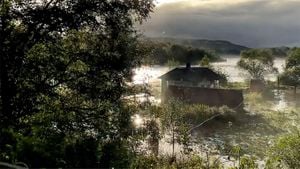The recent Australian bushfires have sparked concern, drawing attention to the efforts of emergency response teams working tirelessly to control the blazes wreaking havoc across the region. From Yarra Glen to Geelong and Tasmania, firefighters have faced fierce conditions fueled by heat and winds, igniting multiple incidents requiring quick and efficient action.
On February 23, 2025, CFA crews were mobilized to combat a grass fire at approximately 9:34 PM near Yarra Glen. According to the CFA spokesperson, "Crews arrived to find a grass fire spreading quickly. The fire spread to about two hectares. It was declared under control at 10 PM, with crews remaining on scene for some time blacking out the last remnants. The incident was eventually declared safe at 12:07 AM on February 24." This swift action showcases the preparedness and prompt response typical of Australian fire crews.
Meanwhile, another fire broke out near Gnarwarre just outside Geelong around 6 PM on the same day. Despite challenging conditions, including extreme heat and strong winds, 25 CFA crews, supported by aerial capabilities, effectively contained the fire originating from a mulch pile. A spokesperson from the Winchelsea Fire Brigade posted on Facebook, noting, "The DGO’s quick thinking and decision to call for more tankers undoubtedly made a significant difference." They emphasized the need for constant vigilance and preparedness when it came to fire safety, calling this incident, "a valuable learning experience for all of us."
While the heroes on the ground battled the flames, the natural environment suffered significantly. Fires along Tasmania’s west coast scorched over 97,000 hectares, prompting the Parks and Wildlife Service to assess and reopen popular hiking trails like the Overland Track. Nic Deka from the Parks and Wildlife Service remarked, "We can assure you the conditions are now safe from fire activity and anyone who had to cancel the Overland Track walk… will be provided a full refund." These efforts to restore access to nature reflect resilience amid adversity.
Efforts to manage the destruction don’t stop with controlling the flames. The bushfires have left deep scars on the local economy, particularly for communities dependent on tourism. Businesses in Halls Gap, located adjacent to the Grampians National Park, endured significant losses during the fires, as many roads remained closed and visitors stayed away. A local commentary acknowledged, "Following such huge events, the local business owners need not miss out altogether... we can do our bit for fire recovery by booking and spending some time in Halls Gap." This sentiment captures not just the economic necessity, but also the communal spirit of support and recovery.
The aftermath of the fires also prompted reflection on environmental practices and sustainability. "Much of the vegetative regrowth will be actively sequestering much carbon out of the atmosphere," noted another local, drawing attention to the natural restorative processes at play. Not only does nature mend itself, but communities also work collaboratively to overcome the challenges posed by such natural disasters.
Perhaps one of the most poignant aspects of this narrative lies within the community's collective response. Volunteer fire crews, composed mainly of locals, tackled the flames, only to return home to care for their farms and animals, often after long shifts on the fire front. One resident remarked on this commitment, saying, "A constant supply of volunteer fire crews being called on...comes at another cost." This highlights the personal sacrifices made by those who step up to protect their communities.
Overall, as these bushfire incidents fade, the lessons learned are invaluable for future preparedness. The community's resilience shines through as they rebuild and share experiences, enhancing their strategies for emergency responses. While climate and environmental challenges persist, the story of the Australian bushfires reminds us of the human spirit's strength and the importance of solidarity during disasters.
From learning plans and responses to recovery and regeneration, the bushfire narrative encapsulates not only the trials faced by communities but also their remarkable capacity to recover and thrive. The call for vigilance and proactive measures will remain pressing as Australia prepares for future fire seasons, leaving communities ready to confront whatever challenges may arise next.



